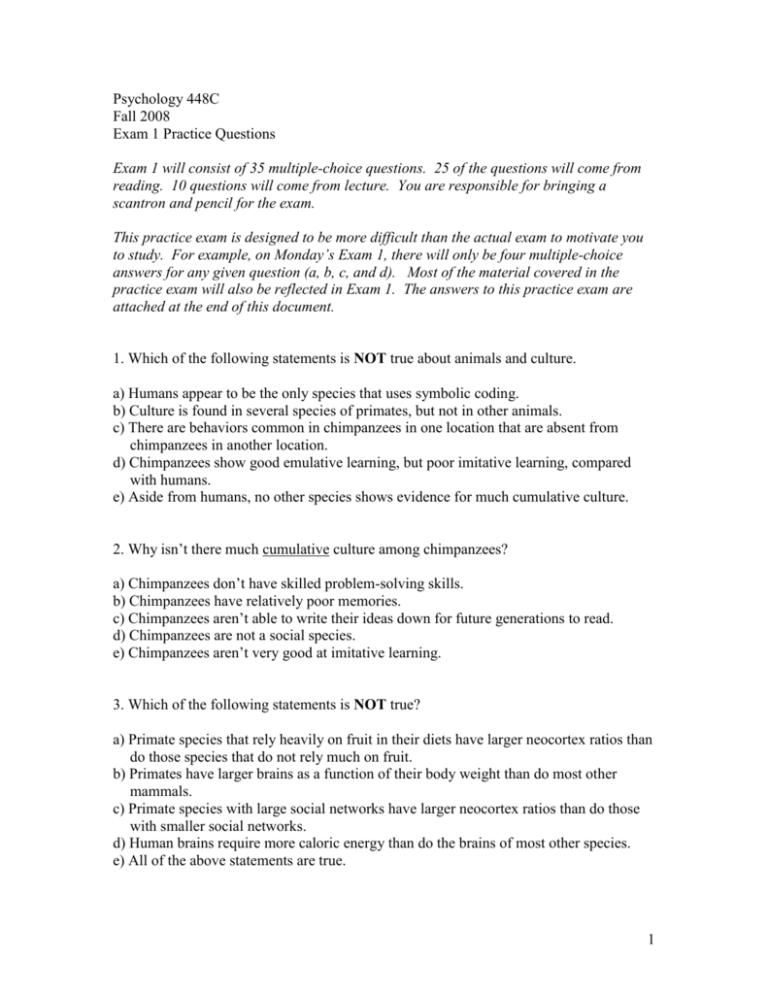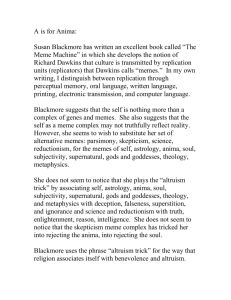Practice Exam
advertisement

Psychology 448C Fall 2008 Exam 1 Practice Questions Exam 1 will consist of 35 multiple-choice questions. 25 of the questions will come from reading. 10 questions will come from lecture. You are responsible for bringing a scantron and pencil for the exam. This practice exam is designed to be more difficult than the actual exam to motivate you to study. For example, on Monday’s Exam 1, there will only be four multiple-choice answers for any given question (a, b, c, and d). Most of the material covered in the practice exam will also be reflected in Exam 1. The answers to this practice exam are attached at the end of this document. 1. Which of the following statements is NOT true about animals and culture. a) Humans appear to be the only species that uses symbolic coding. b) Culture is found in several species of primates, but not in other animals. c) There are behaviors common in chimpanzees in one location that are absent from chimpanzees in another location. d) Chimpanzees show good emulative learning, but poor imitative learning, compared with humans. e) Aside from humans, no other species shows evidence for much cumulative culture. 2. Why isn’t there much cumulative culture among chimpanzees? a) Chimpanzees don’t have skilled problem-solving skills. b) Chimpanzees have relatively poor memories. c) Chimpanzees aren’t able to write their ideas down for future generations to read. d) Chimpanzees are not a social species. e) Chimpanzees aren’t very good at imitative learning. 3. Which of the following statements is NOT true? a) Primate species that rely heavily on fruit in their diets have larger neocortex ratios than do those species that do not rely much on fruit. b) Primates have larger brains as a function of their body weight than do most other mammals. c) Primate species with large social networks have larger neocortex ratios than do those with smaller social networks. d) Human brains require more caloric energy than do the brains of most other species. e) All of the above statements are true. 1 4. The ecology and sex roles are related in the sense that a) men strive to change the surrounding ecology more than women. b) in harsher climates there are more egalitarian sex roles than there are in more benign climates. c) a shortage of food is associated with increases in warfare among men only. d) egalitarian sex roles are more common where food is plentiful and easily acquired. e) the most chauvinistic societies tend to be in areas with the most variable rainfall. 2 5. According to Jared Diamond, why were the germs brought by the Spaniards so much deadlier to the Incans, than were the Incan germs to the Spanish? a) Spaniards had developed cleaner habits than the Incans. b) The Incans lived more closely together such that the Spanish germs were transmitted far more easily. c) The Spaniards had lived in close proximity to domesticated animals for much longer than the Incans. d) The large Eurasian continent allowed Spaniards to be exposed to a larger variety of germs than the relatively smaller South American continent of the Incans. e) The diet of the Spaniards contained more antibiotic agents than did that of the Incans. 6. Genes and memes differ in that a) successful genes are highly fecund, but successful memes are not. b) genes vary randomly, but memes often vary from planned innovations. c) memes typically last longer than genes. d) genes replicate themselves whereas memes do not. e) genes evolve more quickly than memes. 7. A key difference between the epidemiological view of cultural evolution and the “ideas as replicators” view is that a) the epidemiological view predicts faster and more widespread evolution than the ideas as replicators view. b) the epidemiological view is parallel to biological evolution, whereas the ideas as replicators view is different from biological evolution. c) the epidemiological view involves genes whereas the ideas as replicators view involves memes. d) the epidemiological view involves horizontal transmission whereas the ideas as replicators view involves vertical transmission. e) the epidemiological view involves people recreating what they have learned, whereas the ideas as replicators view involves the mere replication of ideas. 8. Which of the following is true about cultural change in the US. a) elderly Americans are less socially engaged now than they were 40 years ago. b) on average, Americans are less likely to belong to formal organizations than they were 40 years ago. c) Americans socialize more now than they did 40 years ago. d) Americans are more trusting now compared with 40 years ago. e) Few Americans bowl now, whereas 40 years ago the vast majority of American adults bowled. 3 9. Which of the following is true about cultural change in the US? a) Americans today score higher on the SAT than they did a generation ago. b) IQ tests reveal trends that all Americans have higher IQs today than they did a generation ago. c) “Culture-bound” IQ tests have shown increases in American intelligence over the past generation, but “Culture-free” IQ tests have not shown any changes. d) IQ increased among Americans in the first half of the century, but has been decreasing since. e) None of the above. 10. An example of a distal cause for Europe’s relative dominance over American indigenous cultures, according to Jared Diamond, is a) Europeans had better weapons than did Native Americans. b) Europeans had monogamous relations. c) Europe was at a similar latitude to a region with many easily domesticated plants and animals. d) Europeans had developed better resistance to more parasites than did Native Americans. e) None of the above. 11. One of the biggest challenges with applying Darwinian principles of natural selection to studying cultural evolution is that a) cultural replication is not of sufficiently high fidelity b) memes do not have sufficient longevity. c) genes are inherited from two parents whereas memes are typically inherited from only one source. d) cultural evolution occurs too slowly to study in controlled settings. e) cultural replication does not depend on fecundity. 12. Pluralistic ignorance is likely to lead to a) rapid cultural evolution b) an overall drop in IQ scores. c) persistence of particular cultural practices, even harmful ones. d) intra-regional cultural variation. e) None of the above. 4 13. What is a problem with using the “back-translation” method? a) You may inadvertently prime your participants to think in ways that are similar to English speakers. b) The literal meaning of the words is sometimes lost. c) The researcher has no way of identifying whether the translators faithfully captured the meaning. d) The translation may sound very unnatural, and may contain idioms that are unintelligible. e) Your participants might not have good enough language skills to understand the materials. 14. One way of correcting for problems associated with an acquiescence bias is to a) use concrete as opposed to subjective response options. b) use a scale with an odd number of response options. c) ensure that the items are thoroughly back-translated. d) reverse-score half of the items. e) None of the above. 15. One way of correcting for problems with reference-group effects is to a) use a scale with an odd number of response options. b) use concrete as opposed to subjective response options. c) reverse-score half of the items. d) ensure that the items are thoroughly back-translated. e) None of the above. 16. An advantage of the situation-sampling method is that a) it can be used with more than one culture at a time. b) it does not require the experimenter to translate any materials. c) it controls for cultural differences in response biases. d) it allows researchers to see how people in different cultures would respond if they were in the other group’s cultural worlds. e) it equates the reference group across cultures. 17. An especial strength of Nisbett and Cohen’s research program into the regional differences in violence between the US South and North is that a) there were no translation issues to deal with. b) they were able to manipulate all of their independent variables. 5 c) they were able to cause Northerners to respond like Southerners. d) there are no response bias differences between these two groups. e) they used multiple methods across their studies. 18. What is a strategy for avoiding problems with the reference-group effect? a) standardizing people’s responses. b) combine the cultures’ respective reference groups. c) reverse scoring half of the items d) counterbalancing the order of the items e) using concrete response options 19. What can be said about sensitive windows for language acquisition? a) Children do not start to acquire any language input before the age of one. b) People who are raised bilingually have two distinct language centers in their brain, that are non-overlapping. c) Some aspects of a language do not show any evidence for sensitive windows for acquisition, such as accents. d) People can learn to speak languages equally well, regardless of age of acquisition. e) None of the above. 20. In comparison with Chinese mothers, American mothers a) are more likely to lead interactions with their children. b) are more likely to introduce topics. c) are more likely to acknowledge children’s perspectives. d) are less likely to discuss their children’s successes. e) None of the above. 21. The “Terrible Twos” is a developmental stage that a) is a myth that really does not exist in any culture. b) exists at different ages across cultures. c) is universally found in all cultures. d) actually extends from the ages of two to six. e) None of the above. 6 22. Cross-cultural research on math achievement at school reveals that a) East Asian children perform better than American children on arithmetic but not trigonometry b) The cultural differences in math achievement are pronounced in elementary school but largely disappear by the time of high school graduation. c) East Asian teachers teach more hours per day on average than American teachers. d) Americans spend more hours on math homework per week than do East Asians. e) Americans are more satisfied with their math performance than are East Asians. 23. When Americans and Japanese complete a self-description using the Twenty Statements Test a) Japanese give more positive statements about themselves than do Americans. b) American statements vary more depending on the context that they were written in than do Japanese statements. c) Americans list more roles and relationships than do Japanese. d) Japanese describe themselves more positively in some contexts than they do in other contexts. e) None of the above. 24. One reason that motivations for self-consistency appear weaker among East Asians than among Westerners is that a) Westerners who are consistent earn more money than do those who are not. b) East Asian parents tend to punish their children when they act consistently. c) Self-consistency correlates more strongly with subjective well-being and with being liked by others in the West than it does in East Asia. d) East Asians tend to complete self-report scales with more extreme opinions than do Westerners. e) None of the above. 25. When Americans and Japanese evaluate themselves in front of a mirror, a) Americans have more positive views of themselves than they normally do. b) Japanese have more positive views of themselves than they normally do. c) Americans have more negative views of themselves than they normally do. d) Japanese have more negative views of themselves than they normally do. e) Japanese self-evaluations are more positive than are American self-evaluations. 7 26. Ma and Schoeneman’s study with Americans and Kenyans found a) Kenyan undergrads and tribal people (e.g., the Samburu) view their selves in very different ways. b) All Kenyan populations had similar kinds of self-views. c) Americans were the only sample in their study that described themselves primarily in terms of personal attributes. d) The Samburu describe themselves primarily in terms of personal attributes. e) None of the above. 27. What is considered moral by those at Kohlberg’s Conventional Level of moral development is a) that which is consistent with the rules. b) that which is associated with the strongest emotions. c) that which is most likely to lead to rewards and is least likely to lead to punishment. d) that which follows the most logically. e) None of the above. 28. Which of the following ethics is not part of Shweder’s model of moral reasoning? a) ethic of autonomy b) ethic of justice c) ethic of community. d) ethic of divinity. e) All of these ethics were proposed in Shweder’s model. 29. Research on morality between Hindu Indians and Americans reveals that a) Americans are more likely than Indians to view interpersonal obligations in full moral terms. b) Indians are not concerned about justice obligations. c) Indians feel that interpersonal obligations are objective and should be legitimately regulated. d) Indians base their morality largely on the ethic of divinity. e) None of the above. 8 30. The moral reasoning of people of orthodox religious sects tend to fit the best with a) preconventional moral reasoning. b) the ethic of community. c) postconventional moral reasoning. d) the ethic of autonomy. e) None of the above. 31. Compared with Jews, Protestants a) are more likely to believe that people have control over their thoughts. b) are more likely to emphasize religious practices. c) are less likely to believe that thoughts lead to actions. d) are more upset about people committing adultery. e) None of the above. 9 Psychology 448C Fall 2008 Exam 1 Practice Questions Correct Answer and location in textbook: 1. b, 5-7 2. e, 9-12 3. a, 18-21 4. d, 47 5. c, 48-50 6. b, 58-60 7. e, 61-62 8. b, 72-73 9. e, 76-81 10. c, 48-50 11. a, 58-60 12. c, 89-90 13. d, 104 14. d, 108 15. b, 110-111 16. d, 118-120 17. e, 133-4 18. e, 110-1 19. e, 139-144 20. c, 155-6 21. e, 162-3 22. e, 171-4 23. d, 198-9 24. c, 206-7 25. c, 212 26. a, 180-2 27. a, 282 28. b, 285 29. c, 289-290 30. e, 296-9 31. a, 306 10








